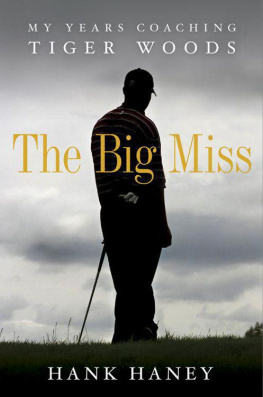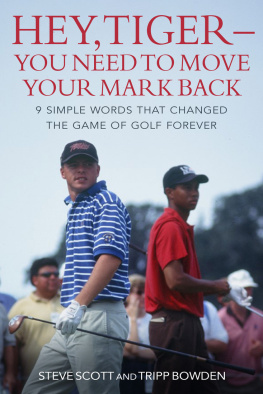Hank Haney - The Big Miss: My Years Coaching Tiger Woods
Here you can read online Hank Haney - The Big Miss: My Years Coaching Tiger Woods full text of the book (entire story) in english for free. Download pdf and epub, get meaning, cover and reviews about this ebook. year: 2012, publisher: Crown Archetype, genre: Children. Description of the work, (preface) as well as reviews are available. Best literature library LitArk.com created for fans of good reading and offers a wide selection of genres:
Romance novel
Science fiction
Adventure
Detective
Science
History
Home and family
Prose
Art
Politics
Computer
Non-fiction
Religion
Business
Children
Humor
Choose a favorite category and find really read worthwhile books. Enjoy immersion in the world of imagination, feel the emotions of the characters or learn something new for yourself, make an fascinating discovery.
- Book:The Big Miss: My Years Coaching Tiger Woods
- Author:
- Publisher:Crown Archetype
- Genre:
- Year:2012
- Rating:5 / 5
- Favourites:Add to favourites
- Your mark:
The Big Miss: My Years Coaching Tiger Woods: summary, description and annotation
We offer to read an annotation, description, summary or preface (depends on what the author of the book "The Big Miss: My Years Coaching Tiger Woods" wrote himself). If you haven't found the necessary information about the book — write in the comments, we will try to find it.
The relationship between the two men began in March 2004 when Hank received a call from Tiger in which the golf champion asked him to be his coach. It was a call that would change both mens lives.
Tigeronly 28 at the timewas by then already an icon, judged by the sporting press as not only one of the best golfers ever, but possibly the bestathleteever. Already he was among the worlds highest paid celebrities. There was an air of mystery surrounding him, an aura of invincibility. Unique among athletes, Tiger seemed to be able to shrug off any level of pressure and find a way to win.
But Tiger was always looking to improve, and he wanted Hanks help.
What Hank soon came to appreciate was that Tiger was one of the most complicated individuals hed ever met, let alone coached. Although Hank had worked with hundreds of elite golfers and was not easily impressed, there were days watching Tiger on the range when Hank couldnt believe what he was witnessing. On those days, it was impossible to imagine anotherhuman playing golf so perfectly.
And yet Tigerishumanand Hanks expert eye was adept at spotting where Tigers perfection ended and an opportunity for improvement existed. Always haunting Tiger was his fear of the big missthe wildly inaccurate golf shot that can ruin an otherwise solid roundand it was because that type of blunder was sometimes part of Tigers game that Hank carefully redesigned his swing mechanics.
Hanksmost formidablecoaching challenge, though, would be solving the riddle of Tigers personality. Wary of the emotional distractions that might diminish his game and put him further from his goals, Tiger had developed a variety of tactics to keep people from getting too close, and not even Hankor Tigers family and friends, for that matterwas spared the treatment.
Toward the end of Tiger and Hanks time together, the champions laser-like focus began to blur and he became less willing to put in punishing hours practicinga disappointment to Hank, who saw in Tigers behavior signs that his pupil had developed a conflicted relationship with the game. Hints that Tiger hungered to reinvent himself were present in his bizarre infatuation with elite military training, andin a development Hankdidntsee comingin the scandal that would make headlines in late 2009. It all added up to a big miss that Hank, try as he might, couldnt save Tiger from.
Theres never been a book about Tiger Woods that is as intimate and revealingor one so wise about what it takes to coach a superstar athlete.
Hank Haney: author's other books
Who wrote The Big Miss: My Years Coaching Tiger Woods? Find out the surname, the name of the author of the book and a list of all author's works by series.







